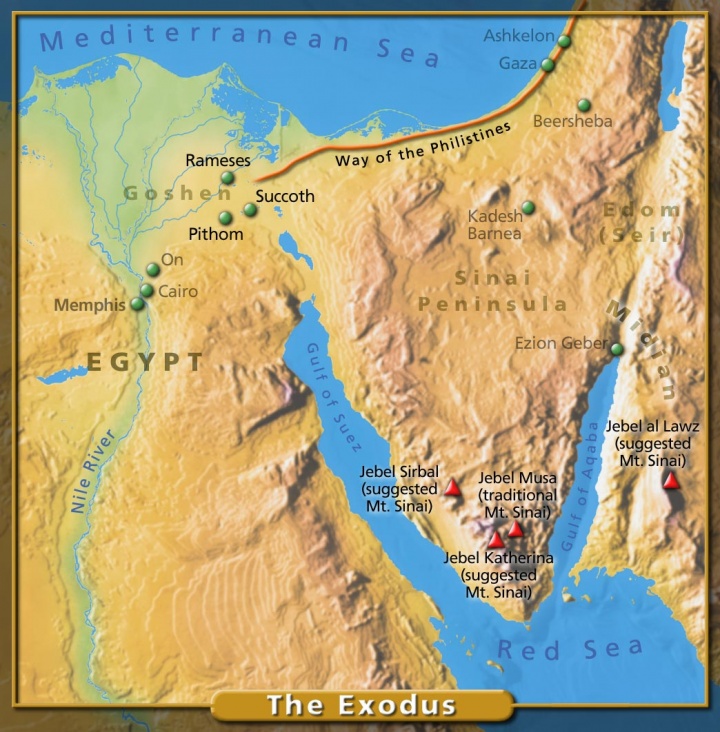Bible Commentary
Exodus 13:17-14:31
Miracle at the Red Sea
God brought Israel out of Egypt through great signs and wonders. He had communicated to them through His servant Moses and was now miraculously leading them through the wilderness. Israel was now witnessing another miracle—God leading them by a pillar of cloud during the day, which brought welcome shade during the afternoon heat (Psalm 105:39; compare Isaiah 4:5-6; Isaiah 25:4-5), and by a pillar of fire during the night, which gave them a warm, glowing light. But He was leading them in a way that did not seem to make sense, since it was not in the direction of Canaan and was, instead, heading toward a dead-end entrapment. Pharaoh had once again changed his mind, and now the Israelites found themselves trapped between his army and the sea.
One might think that, after witnessing the tremendous miracles that had already taken place, the Israelites would begin to show evidence of trust and faith in the One who had delivered them thus far. Instead, we find a continually complaining, murmuring and backsliding group of people who just aren't getting the point! However, God reminds us that these ancient examples have been recorded for our benefit today (1 Corinthians 10:13). The people, places and events may be different, but the attitudes prevail throughout the ages.
Are we that different today? Do we ever find ourselves questioning the existence or whereabouts of our Creator? Do we ever doubt God's miraculous intervention in our lives? Do we ever complain, gripe or murmur when things don't seem to be going our way? When our backs are to the "Red Sea" with no relief in sight, do we trust in the words, "Stand still, and see the salvation of the Lord"? An end-time event is yet to occur that will test the faith of God's elect (Revelation 12:13-16). Will God's people remember His miracles, or will they be like the Israelites of old? If one can read about and believe in the One who was so patient, loving and merciful to a stubborn and stiff-necked people, why would one doubt His patience, love and mercy for today? God does not show partiality (Acts 10:34).
While the armies of Pharaoh were encompassed by the dark of the night, the pillar of fire was guiding millions of Israelites, a mixed multitude and millions of animals over the dried bed of the Red Sea. This was an enormous undertaking. One scholar, estimating the throng numbered 2.5 million—when it was likely closer to 3—mathematically "figured that marching ten abreast, the numbers would have formed a line over 150 miles long, and would have required eight or nine days to march by any fixed point" (Jonathan Kirsch, Moses, A Life, p. 175). Obviously since they crossed the Red Sea in a single night, the Israelites were lined up in numbers much greater than ten abreast—probably more like hundreds or thousands abreast!
Pharaoh's rebelliousness was finally brought to an end, then, in a miraculous series of events that all were able to witness. Many have claimed that the Israelites simply walked across a marsh or shallow lake when the water level was low. Part of their argument is that the original Hebrew term translated "Red Sea" is Yam Suf, meaning "Sea of Reeds"—reeds being plants like cattails, rushes and papyrus. However, the word suf can also mean seaweed (Jonah 2:5). In fact, the Gulf of Aqaba, a finger of the Red Sea, is actually called Yam Suf in 1 Kings 9:26. Others, accepting this, will argue that the Israelites were walking on a sandbar at low tide—while the Egyptians got swept away when the tide came in. Yet the Bible clearly says that the waters were a "wall" to the Israelites on both sides (Exodus 14:22)—an awesome miracle that cannot be explained by a coincidence of natural phenomena.
To quote biblical historian Eugene Merrill: "The crossing of Israel, which immediately preceded the drowning of the Egyptian chariotry, cannot be explained as a wading through a swamp. It required a mighty act of God, an act so significant in both scope and meaning that forever after in Israel's history it was the paradigm against which all of his redemptive and saving work was measured. If there was no actual miracle of the proportions described, all subsequent references to the exodus as the archetype of the sovereign power and salvific grace of God is hollow and empty" (Kingdom of Priests, p. 66).
Through this incredible symbolic baptism (1 Corinthians 10:2), would the Israelites emerge with a renewed attitude?
 UCG.org
UCG.org Supplementary Reading: “The Exodus Controversy”, Good News Magazine, March-April 2002, pp. 8-11, 28.